LEMT305: Leadership Reflective Journal - Kent Institute Australia
VerifiedAdded on 2023/06/11
|6
|1252
|153
Journal and Reflective Writing
AI Summary
This reflective journal delves into the core concepts and theories of leadership, exploring their application to personal experiences and practical knowledge. It covers various perspectives, including trait, behavioral, individualized, and contingency approaches, highlighting the shift from traditional paradigms to modern, enlightened leadership focused on empowerment and collaboration. The journal examines leadership as an individual, emphasizing personality dimensions, moral development, and authentic leadership, alongside the significance of followership and community building. Furthermore, it addresses motivation, empowerment, leadership communication, team dynamics, diversity, and the effective use of power and influence, providing a comprehensive understanding of leadership in diverse contexts. Desklib offers a wealth of resources, including past papers and solved assignments, to support students in their academic journey.
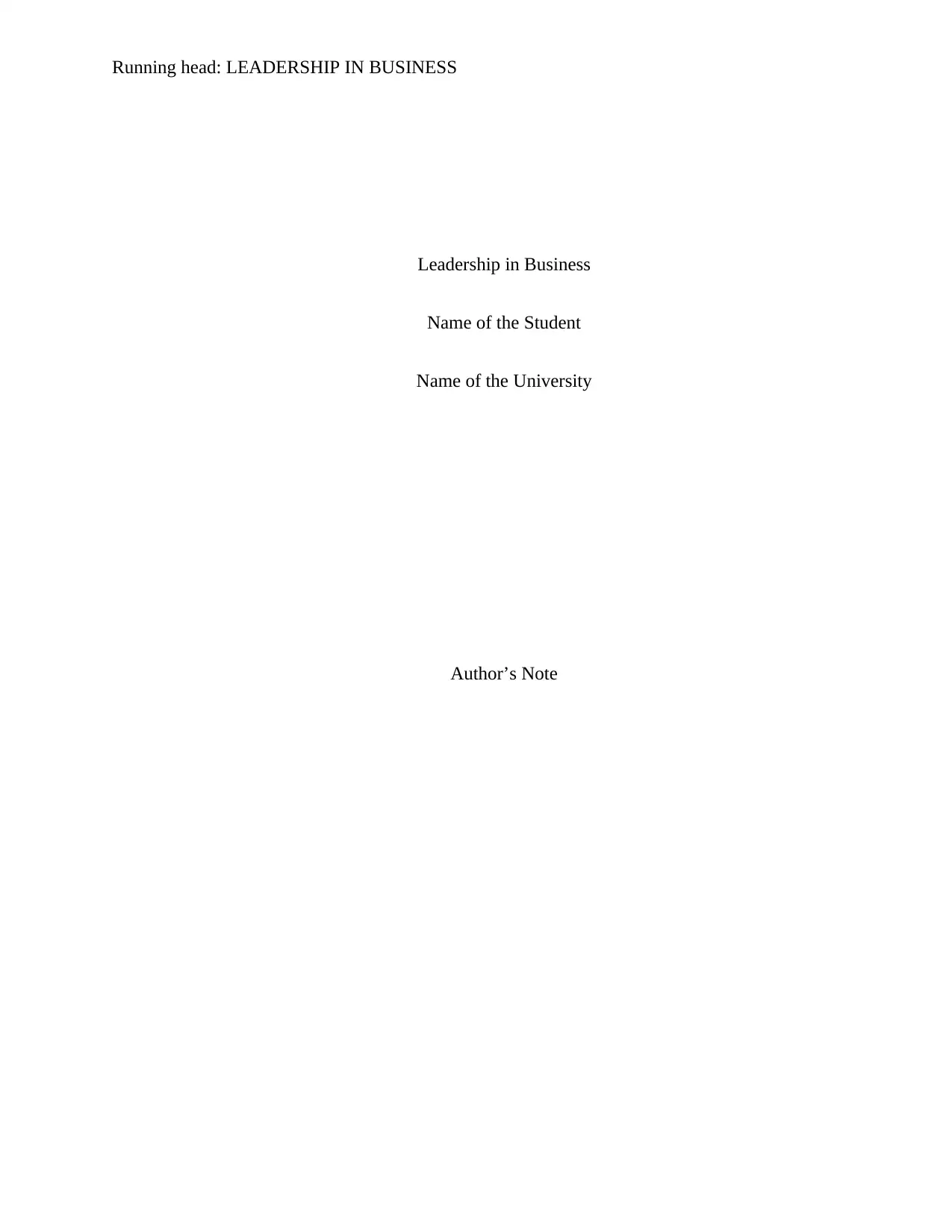
Running head: LEADERSHIP IN BUSINESS
Leadership in Business
Name of the Student
Name of the University
Author’s Note
Leadership in Business
Name of the Student
Name of the University
Author’s Note
Paraphrase This Document
Need a fresh take? Get an instant paraphrase of this document with our AI Paraphraser
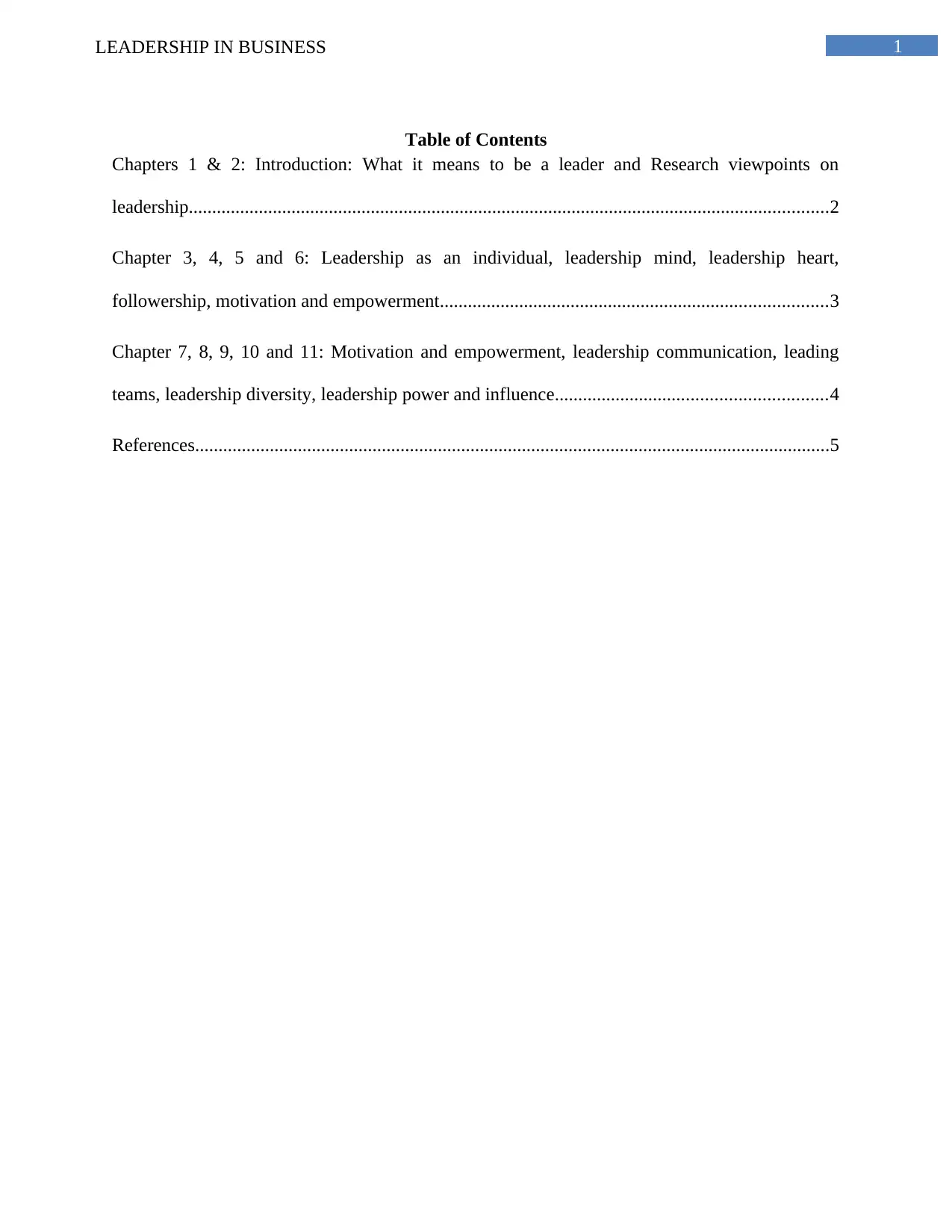
1LEADERSHIP IN BUSINESS
Table of Contents
Chapters 1 & 2: Introduction: What it means to be a leader and Research viewpoints on
leadership.........................................................................................................................................2
Chapter 3, 4, 5 and 6: Leadership as an individual, leadership mind, leadership heart,
followership, motivation and empowerment...................................................................................3
Chapter 7, 8, 9, 10 and 11: Motivation and empowerment, leadership communication, leading
teams, leadership diversity, leadership power and influence..........................................................4
References........................................................................................................................................5
Table of Contents
Chapters 1 & 2: Introduction: What it means to be a leader and Research viewpoints on
leadership.........................................................................................................................................2
Chapter 3, 4, 5 and 6: Leadership as an individual, leadership mind, leadership heart,
followership, motivation and empowerment...................................................................................3
Chapter 7, 8, 9, 10 and 11: Motivation and empowerment, leadership communication, leading
teams, leadership diversity, leadership power and influence..........................................................4
References........................................................................................................................................5
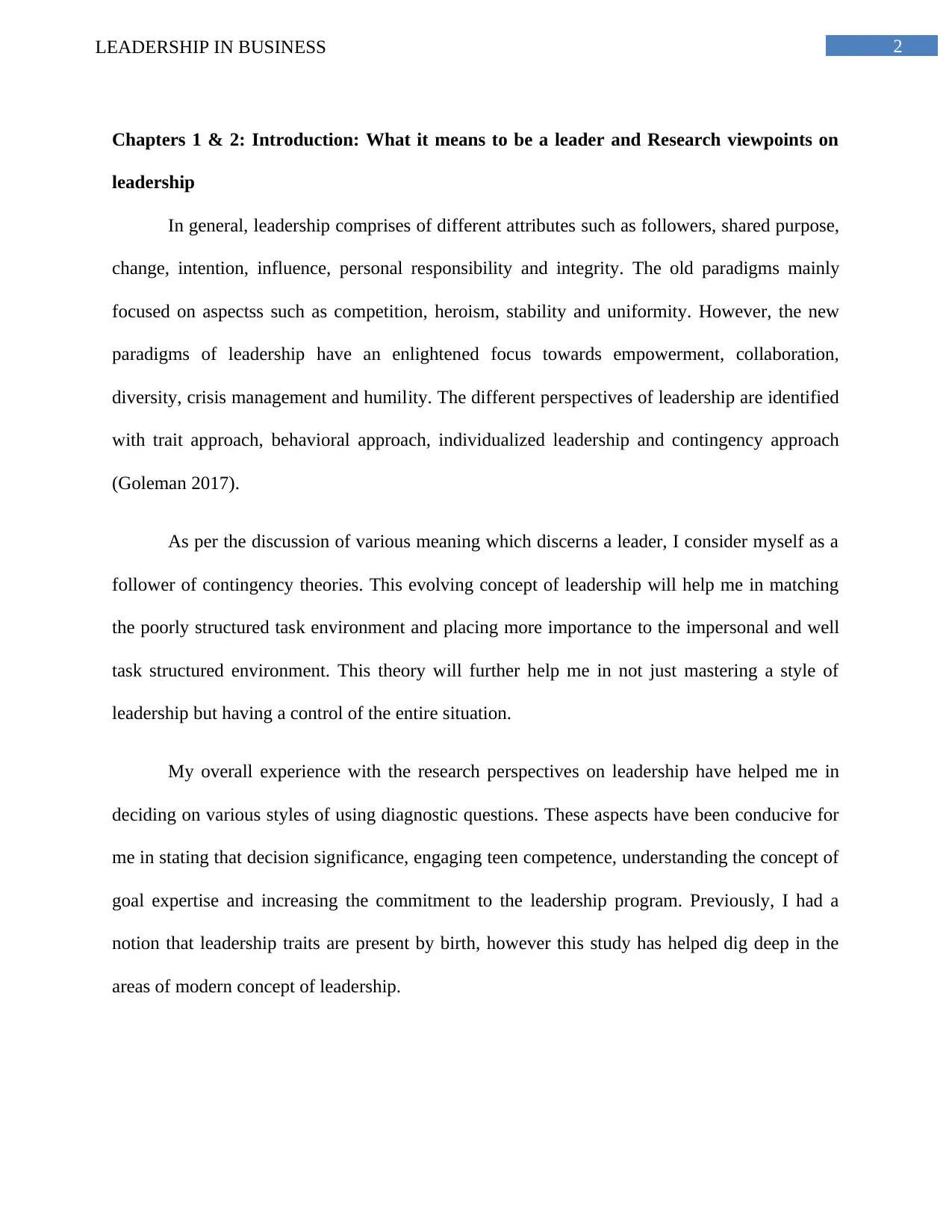
2LEADERSHIP IN BUSINESS
Chapters 1 & 2: Introduction: What it means to be a leader and Research viewpoints on
leadership
In general, leadership comprises of different attributes such as followers, shared purpose,
change, intention, influence, personal responsibility and integrity. The old paradigms mainly
focused on aspectss such as competition, heroism, stability and uniformity. However, the new
paradigms of leadership have an enlightened focus towards empowerment, collaboration,
diversity, crisis management and humility. The different perspectives of leadership are identified
with trait approach, behavioral approach, individualized leadership and contingency approach
(Goleman 2017).
As per the discussion of various meaning which discerns a leader, I consider myself as a
follower of contingency theories. This evolving concept of leadership will help me in matching
the poorly structured task environment and placing more importance to the impersonal and well
task structured environment. This theory will further help me in not just mastering a style of
leadership but having a control of the entire situation.
My overall experience with the research perspectives on leadership have helped me in
deciding on various styles of using diagnostic questions. These aspects have been conducive for
me in stating that decision significance, engaging teen competence, understanding the concept of
goal expertise and increasing the commitment to the leadership program. Previously, I had a
notion that leadership traits are present by birth, however this study has helped dig deep in the
areas of modern concept of leadership.
Chapters 1 & 2: Introduction: What it means to be a leader and Research viewpoints on
leadership
In general, leadership comprises of different attributes such as followers, shared purpose,
change, intention, influence, personal responsibility and integrity. The old paradigms mainly
focused on aspectss such as competition, heroism, stability and uniformity. However, the new
paradigms of leadership have an enlightened focus towards empowerment, collaboration,
diversity, crisis management and humility. The different perspectives of leadership are identified
with trait approach, behavioral approach, individualized leadership and contingency approach
(Goleman 2017).
As per the discussion of various meaning which discerns a leader, I consider myself as a
follower of contingency theories. This evolving concept of leadership will help me in matching
the poorly structured task environment and placing more importance to the impersonal and well
task structured environment. This theory will further help me in not just mastering a style of
leadership but having a control of the entire situation.
My overall experience with the research perspectives on leadership have helped me in
deciding on various styles of using diagnostic questions. These aspects have been conducive for
me in stating that decision significance, engaging teen competence, understanding the concept of
goal expertise and increasing the commitment to the leadership program. Previously, I had a
notion that leadership traits are present by birth, however this study has helped dig deep in the
areas of modern concept of leadership.
⊘ This is a preview!⊘
Do you want full access?
Subscribe today to unlock all pages.

Trusted by 1+ million students worldwide
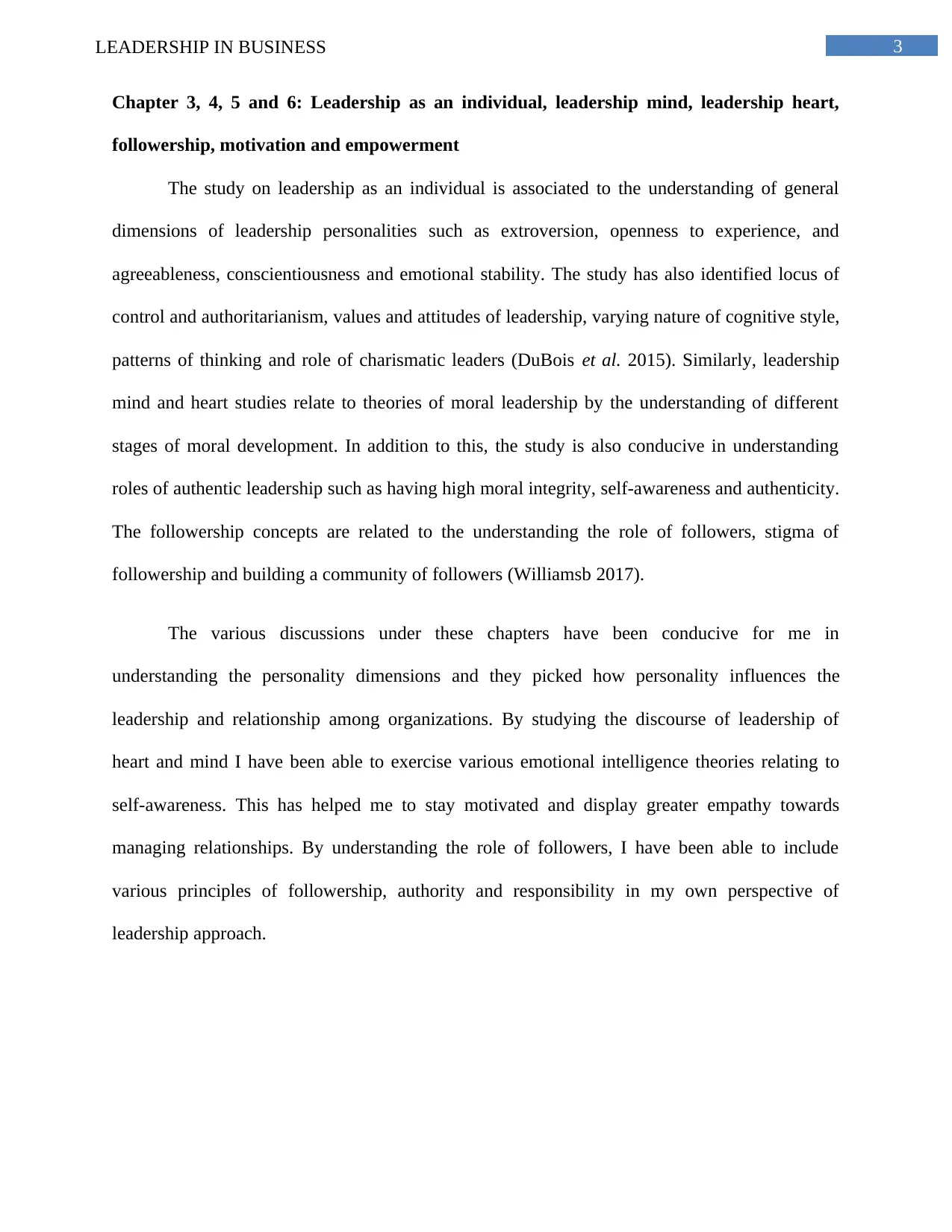
3LEADERSHIP IN BUSINESS
Chapter 3, 4, 5 and 6: Leadership as an individual, leadership mind, leadership heart,
followership, motivation and empowerment
The study on leadership as an individual is associated to the understanding of general
dimensions of leadership personalities such as extroversion, openness to experience, and
agreeableness, conscientiousness and emotional stability. The study has also identified locus of
control and authoritarianism, values and attitudes of leadership, varying nature of cognitive style,
patterns of thinking and role of charismatic leaders (DuBois et al. 2015). Similarly, leadership
mind and heart studies relate to theories of moral leadership by the understanding of different
stages of moral development. In addition to this, the study is also conducive in understanding
roles of authentic leadership such as having high moral integrity, self-awareness and authenticity.
The followership concepts are related to the understanding the role of followers, stigma of
followership and building a community of followers (Williamsb 2017).
The various discussions under these chapters have been conducive for me in
understanding the personality dimensions and they picked how personality influences the
leadership and relationship among organizations. By studying the discourse of leadership of
heart and mind I have been able to exercise various emotional intelligence theories relating to
self-awareness. This has helped me to stay motivated and display greater empathy towards
managing relationships. By understanding the role of followers, I have been able to include
various principles of followership, authority and responsibility in my own perspective of
leadership approach.
Chapter 3, 4, 5 and 6: Leadership as an individual, leadership mind, leadership heart,
followership, motivation and empowerment
The study on leadership as an individual is associated to the understanding of general
dimensions of leadership personalities such as extroversion, openness to experience, and
agreeableness, conscientiousness and emotional stability. The study has also identified locus of
control and authoritarianism, values and attitudes of leadership, varying nature of cognitive style,
patterns of thinking and role of charismatic leaders (DuBois et al. 2015). Similarly, leadership
mind and heart studies relate to theories of moral leadership by the understanding of different
stages of moral development. In addition to this, the study is also conducive in understanding
roles of authentic leadership such as having high moral integrity, self-awareness and authenticity.
The followership concepts are related to the understanding the role of followers, stigma of
followership and building a community of followers (Williamsb 2017).
The various discussions under these chapters have been conducive for me in
understanding the personality dimensions and they picked how personality influences the
leadership and relationship among organizations. By studying the discourse of leadership of
heart and mind I have been able to exercise various emotional intelligence theories relating to
self-awareness. This has helped me to stay motivated and display greater empathy towards
managing relationships. By understanding the role of followers, I have been able to include
various principles of followership, authority and responsibility in my own perspective of
leadership approach.
Paraphrase This Document
Need a fresh take? Get an instant paraphrase of this document with our AI Paraphraser
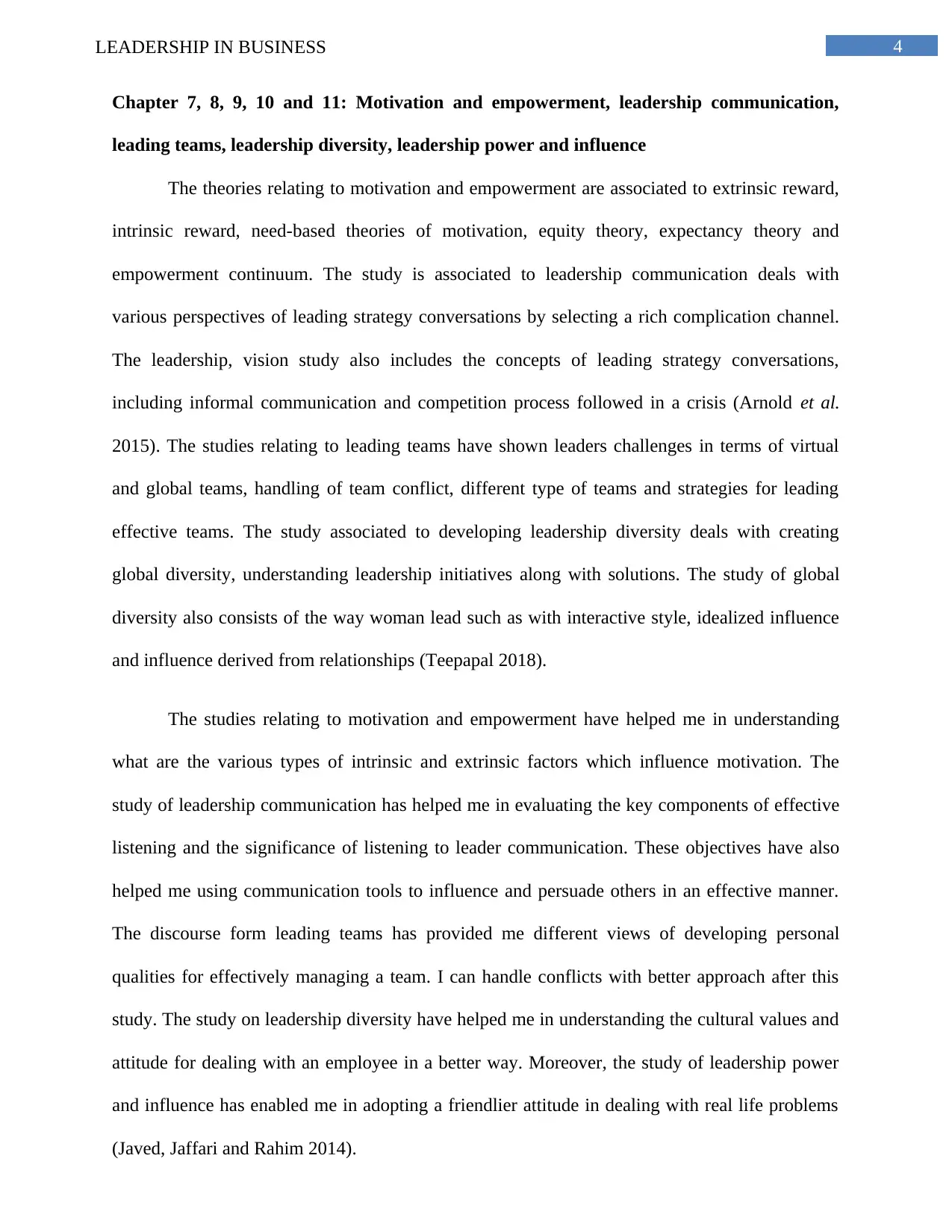
4LEADERSHIP IN BUSINESS
Chapter 7, 8, 9, 10 and 11: Motivation and empowerment, leadership communication,
leading teams, leadership diversity, leadership power and influence
The theories relating to motivation and empowerment are associated to extrinsic reward,
intrinsic reward, need-based theories of motivation, equity theory, expectancy theory and
empowerment continuum. The study is associated to leadership communication deals with
various perspectives of leading strategy conversations by selecting a rich complication channel.
The leadership, vision study also includes the concepts of leading strategy conversations,
including informal communication and competition process followed in a crisis (Arnold et al.
2015). The studies relating to leading teams have shown leaders challenges in terms of virtual
and global teams, handling of team conflict, different type of teams and strategies for leading
effective teams. The study associated to developing leadership diversity deals with creating
global diversity, understanding leadership initiatives along with solutions. The study of global
diversity also consists of the way woman lead such as with interactive style, idealized influence
and influence derived from relationships (Teepapal 2018).
The studies relating to motivation and empowerment have helped me in understanding
what are the various types of intrinsic and extrinsic factors which influence motivation. The
study of leadership communication has helped me in evaluating the key components of effective
listening and the significance of listening to leader communication. These objectives have also
helped me using communication tools to influence and persuade others in an effective manner.
The discourse form leading teams has provided me different views of developing personal
qualities for effectively managing a team. I can handle conflicts with better approach after this
study. The study on leadership diversity have helped me in understanding the cultural values and
attitude for dealing with an employee in a better way. Moreover, the study of leadership power
and influence has enabled me in adopting a friendlier attitude in dealing with real life problems
(Javed, Jaffari and Rahim 2014).
Chapter 7, 8, 9, 10 and 11: Motivation and empowerment, leadership communication,
leading teams, leadership diversity, leadership power and influence
The theories relating to motivation and empowerment are associated to extrinsic reward,
intrinsic reward, need-based theories of motivation, equity theory, expectancy theory and
empowerment continuum. The study is associated to leadership communication deals with
various perspectives of leading strategy conversations by selecting a rich complication channel.
The leadership, vision study also includes the concepts of leading strategy conversations,
including informal communication and competition process followed in a crisis (Arnold et al.
2015). The studies relating to leading teams have shown leaders challenges in terms of virtual
and global teams, handling of team conflict, different type of teams and strategies for leading
effective teams. The study associated to developing leadership diversity deals with creating
global diversity, understanding leadership initiatives along with solutions. The study of global
diversity also consists of the way woman lead such as with interactive style, idealized influence
and influence derived from relationships (Teepapal 2018).
The studies relating to motivation and empowerment have helped me in understanding
what are the various types of intrinsic and extrinsic factors which influence motivation. The
study of leadership communication has helped me in evaluating the key components of effective
listening and the significance of listening to leader communication. These objectives have also
helped me using communication tools to influence and persuade others in an effective manner.
The discourse form leading teams has provided me different views of developing personal
qualities for effectively managing a team. I can handle conflicts with better approach after this
study. The study on leadership diversity have helped me in understanding the cultural values and
attitude for dealing with an employee in a better way. Moreover, the study of leadership power
and influence has enabled me in adopting a friendlier attitude in dealing with real life problems
(Javed, Jaffari and Rahim 2014).
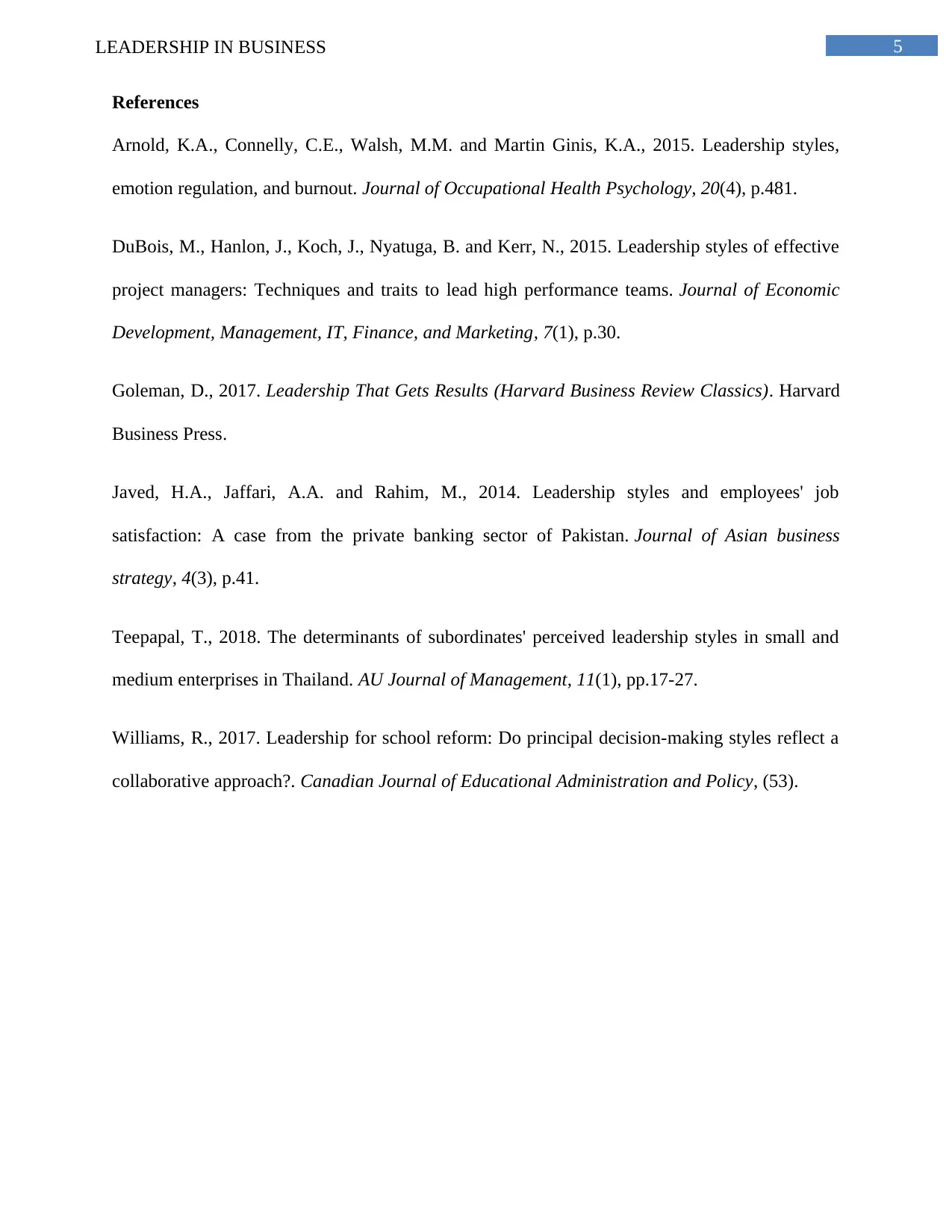
5LEADERSHIP IN BUSINESS
References
Arnold, K.A., Connelly, C.E., Walsh, M.M. and Martin Ginis, K.A., 2015. Leadership styles,
emotion regulation, and burnout. Journal of Occupational Health Psychology, 20(4), p.481.
DuBois, M., Hanlon, J., Koch, J., Nyatuga, B. and Kerr, N., 2015. Leadership styles of effective
project managers: Techniques and traits to lead high performance teams. Journal of Economic
Development, Management, IT, Finance, and Marketing, 7(1), p.30.
Goleman, D., 2017. Leadership That Gets Results (Harvard Business Review Classics). Harvard
Business Press.
Javed, H.A., Jaffari, A.A. and Rahim, M., 2014. Leadership styles and employees' job
satisfaction: A case from the private banking sector of Pakistan. Journal of Asian business
strategy, 4(3), p.41.
Teepapal, T., 2018. The determinants of subordinates' perceived leadership styles in small and
medium enterprises in Thailand. AU Journal of Management, 11(1), pp.17-27.
Williams, R., 2017. Leadership for school reform: Do principal decision-making styles reflect a
collaborative approach?. Canadian Journal of Educational Administration and Policy, (53).
References
Arnold, K.A., Connelly, C.E., Walsh, M.M. and Martin Ginis, K.A., 2015. Leadership styles,
emotion regulation, and burnout. Journal of Occupational Health Psychology, 20(4), p.481.
DuBois, M., Hanlon, J., Koch, J., Nyatuga, B. and Kerr, N., 2015. Leadership styles of effective
project managers: Techniques and traits to lead high performance teams. Journal of Economic
Development, Management, IT, Finance, and Marketing, 7(1), p.30.
Goleman, D., 2017. Leadership That Gets Results (Harvard Business Review Classics). Harvard
Business Press.
Javed, H.A., Jaffari, A.A. and Rahim, M., 2014. Leadership styles and employees' job
satisfaction: A case from the private banking sector of Pakistan. Journal of Asian business
strategy, 4(3), p.41.
Teepapal, T., 2018. The determinants of subordinates' perceived leadership styles in small and
medium enterprises in Thailand. AU Journal of Management, 11(1), pp.17-27.
Williams, R., 2017. Leadership for school reform: Do principal decision-making styles reflect a
collaborative approach?. Canadian Journal of Educational Administration and Policy, (53).
⊘ This is a preview!⊘
Do you want full access?
Subscribe today to unlock all pages.

Trusted by 1+ million students worldwide
1 out of 6
Related Documents
Your All-in-One AI-Powered Toolkit for Academic Success.
+13062052269
info@desklib.com
Available 24*7 on WhatsApp / Email
![[object Object]](/_next/static/media/star-bottom.7253800d.svg)
Unlock your academic potential
Copyright © 2020–2025 A2Z Services. All Rights Reserved. Developed and managed by ZUCOL.




